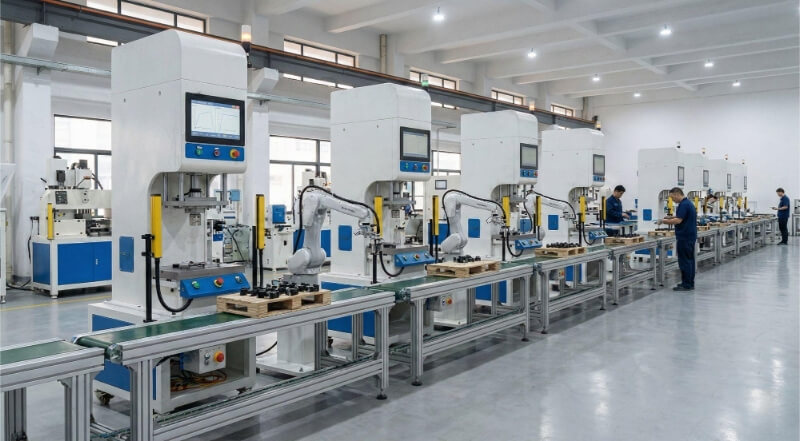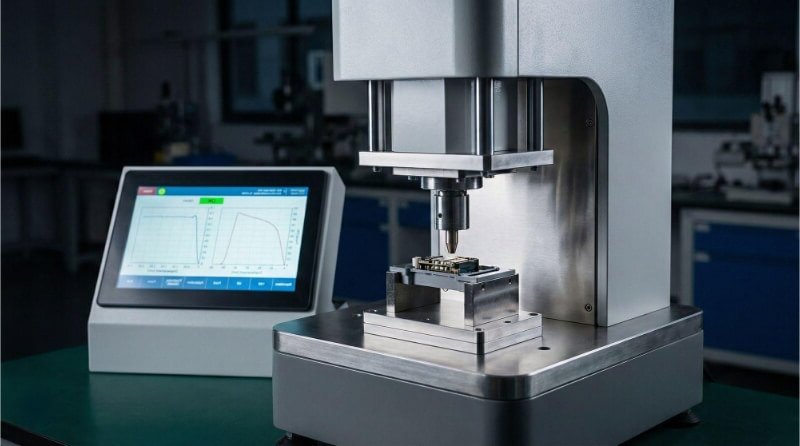프로젝트에서 단단한 금속을 절단하거나 복잡한 모양을 만들어야 할 때는 적절한 EDM 방법을 선택하는 것이 필수적입니다. 결정하기 어려울 수 있지만, 와이어 EDM과 싱커 EDM의 차이점을 알면 큰 도움이 됩니다. 각 방법에는 고유한 용도가 있으며, 올바른 방법을 선택하면 나중에 시간, 비용, 골칫거리를 줄일 수 있습니다.
와이어 EDM은 얇은 와이어를 사용하여 전기 불꽃으로 금속을 절단합니다. 미세하고 섬세한 작업에 가장 적합합니다. 싱커 EDM은 모양이 있는 전극을 사용하여 재료를 태우는 방식으로 깊은 구멍에 적합합니다. 와이어 EDM은 정밀한 절단과 깨끗한 모서리를 제공합니다. 싱커 EDM은 더 두꺼운 파트와 복잡한 내부 피처를 처리합니다. 필요한 부품 모양, 크기 및 정확도에 따라 선택할 수 있습니다.
와이어와 싱커 EDM은 서로 다른 문제를 해결합니다. 올바른 선택을 하려면 각 솔루션의 작동 방식과 장점을 고려해야 합니다.
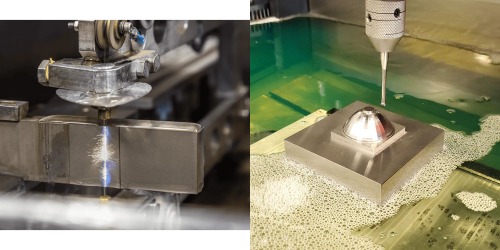
와이어 EDM이란?
와이어 EDM 는 와이어 방전 가공을 의미합니다. 얇은 금속 와이어를 전극으로 사용합니다. 이 와이어는 전기 스파크를 생성하여 금속을 절단합니다. 와이어는 재료에 닿지 않습니다. 대신 스파크가 작업을 수행합니다.
전체 공정은 탈이온수로 채워진 탱크에서 이루어집니다. 이는 스파크를 제어하고 부품을 냉각하는 데 도움이 됩니다. 와이어는 CNC 시스템의 안내에 따라 프로그래밍된 경로를 따라 이동합니다.
일반적으로 황동 또는 아연 코팅 구리로 만들어진 와이어가 두 개의 스풀 사이를 이동합니다. 와이어는 물리적인 접촉 없이 공작물을 통과합니다. 스파크가 와이어에서 금속으로 점프하여 작은 금속 조각을 녹여 증발시킵니다.
기계가 지속적으로 물로 해당 부위를 세척하여 이물질을 제거하고 절단 부위를 깨끗하게 유지합니다. 와이어는 지속적으로 공급되므로 날카롭고 정확한 상태를 유지합니다.
와이어 EDM은 느리지만 매우 정밀합니다. 단단한 재료의 복잡한 모양을 절단하는 데 적합합니다.
와이어 EDM에 적합한 재료
와이어 EDM은 전도성 재료에서 가장 잘 작동합니다. 금속은 전류를 전달해야 합니다. 여기에는 다음이 포함됩니다:
- 공구강
- 스테인레스 스틸
- 티탄
- 텅스텐
- 알류미늄
- 카바이드
- 인코넬
플라스틱이나 세라믹과 같은 비전도성 소재에서는 작동하지 않습니다.
와이어 EDM의 장단점
장점:
- 복잡한 모양을 ±0.0001인치 정밀도로 자릅니다.
- 물리적인 힘을 가하지 않아도 파트 왜곡이 줄어듭니다.
- 어닐링 없이 경화된 소재에 사용할 수 있습니다.
단점:
- 단순한 모양의 경우 밀링보다 느립니다.
- 스루컷으로 제한됩니다(블라인드 홀 없음).
- 전선 소비로 인한 운영 비용 증가.
와이어 EDM의 일반적인 애플리케이션
와이어 EDM은 정확성과 세밀한 디테일이 중요한 곳에 사용됩니다. 일반적인 용도는 다음과 같습니다:
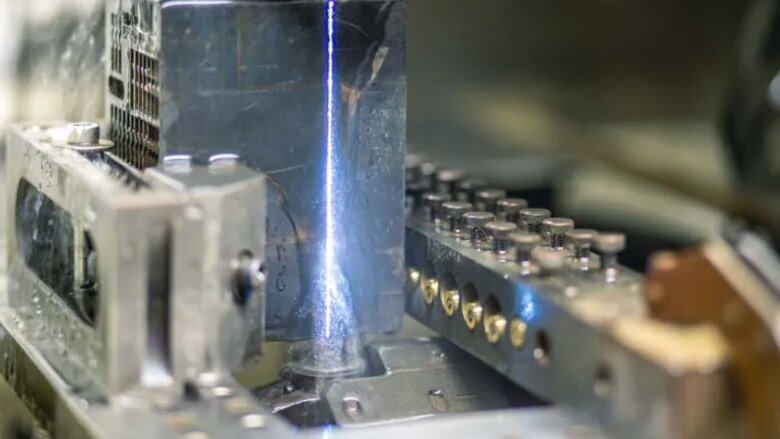
싱커 EDM이란 무엇인가요?
싱커 EDM 램 EDM 또는 캐비티 EDM이라고도 합니다. 맞춤형 모양의 전극을 사용하여 금속 부품에 "싱크"합니다. 이 방법은 절삭 공구 없이 공작물을 성형합니다. 대신 스파크 침식에 의존하여 재료를 제거합니다.
전극과 공작물이 닿지 않습니다. 제어된 환경에서 전기 스파크가 전극과 공작물 사이를 점프합니다. 전극의 모양에 따라 캐비티의 최종 형태나 디테일이 결정됩니다.
먼저 구리 또는 흑연으로 고체 전극을 만듭니다. 이 전극은 원하는 캐비티와 일치하도록 모양을 만듭니다. 그런 다음 기계가 전극을 금속 부품으로 이동시킵니다. 전기 방전이 금속을 태우는 스파크를 생성합니다.
이 과정은 스파크를 제어하고 입자를 씻어내는 데 도움이 되는 유전체 유체(일반적으로 오일)에서 이루어집니다. 전극은 거의 침식되지 않으며 제거되는 대부분의 물질은 공작물에서 나옵니다.
싱커 EDM은 금형이나 금형 제작과 같이 동일한 모양을 반복해야 할 때 가장 효과적입니다.
싱커 EDM에 적합한 재료
싱커 EDM은 모든 전도성 소재에서 작동합니다. 여기에는 다음이 포함됩니다:
- 공구강
- 스테인리스 스틸
- 강화 강철
- 티탄
- 인코넬
- 카바이드
- 알류미늄
재료는 전기를 전도해야 합니다. 와이어 EDM과 마찬가지로 비전도성 재료는 제외됩니다.
싱커 EDM의 장단점
장점:
- 깊고 복잡한 3D 모양을 처리합니다.
- 절삭력이 없습니다(섬세한 부품에 적합).
- 미세한 표면 마감(최저 Ra 0.1µm).
단점:
- 단순한 기능의 경우 CNC 밀링보다 느립니다.
- 전극 마모는 대량 작업의 비용을 증가시킵니다.
- 최적의 결과를 얻으려면 숙련된 설정이 필요합니다.
싱커 EDM의 일반적인 애플리케이션
싱커 EDM은 깊거나 복잡한 캐비티가 있는 파트를 제작하는 데 사용됩니다. 인기 있는 분야입니다:
- 몰드 및 다이: 사출 금형, 단조 금형.
- 항공우주: 터빈 블레이드 냉각 구멍.
- 자동차: 변속기 기어, 연료 인젝터.
- 의료: 임플란트 몰드, 미세 수술 도구.
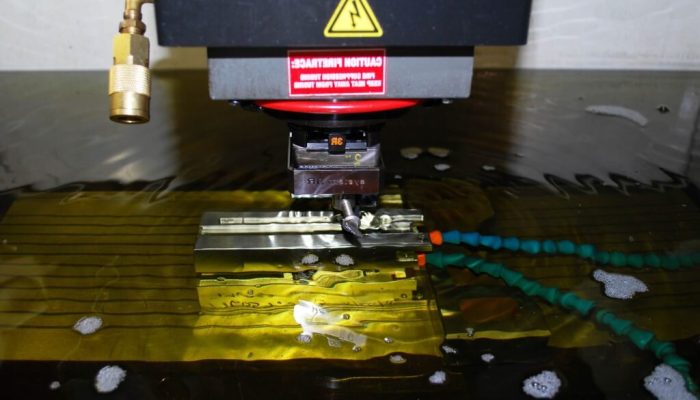
와이어 EDM과 싱커 EDM: 차이점은 무엇인가요?
두 방법 모두 전기 스파크를 사용하여 금속을 성형합니다. 하지만 이 두 가지 방법의 방식과 가장 잘할 수 있는 부분은 크게 다릅니다.
가공 프로세스
와이어 EDM은 경로를 따라 움직이는 가는 와이어를 사용하여 부품을 절단합니다. 띠톱처럼 작동하지만 칼날 대신 불꽃을 사용합니다.
싱커 EDM은 부품에 밀어 넣어 캐비티 또는 몰드를 형성하는 모양의 전극을 사용합니다. 절단하는 것이 아니라 내부를 성형합니다.
정밀도 및 허용 오차
와이어 EDM은 더 높은 정밀도를 제공합니다. 0.0001인치의 오차 범위까지 정밀하게 가공할 수 있어 세밀한 프로파일과 좁은 모서리에 이상적입니다.
싱커 EDM은 정확하지만 일반적으로 와이어 EDM만큼 정밀하지는 않습니다. 허용 오차는 ±0.0002인치 정도가 일반적입니다. 깊거나 복잡한 캐비티 작업에 가장 적합합니다.
전극 와이어
와이어 EDM은 일반적으로 황동 또는 구리로 코팅된 연속적으로 공급되는 와이어를 사용합니다. 와이어는 절단 도구 역할을 하며 항상 움직입니다.
싱커 EDM은 흑연 또는 구리로 만든 맞춤형 고체 전극을 사용합니다. 이 전극의 모양은 원하는 부품의 형상과 일치합니다.
재료 제거 기능
와이어 EDM은 단일 평면 또는 경로를 따라 재료를 제거합니다. 직선 또는 윤곽이 있는 프로파일 절단에 탁월합니다.
싱커 EDM은 파트 내부의 대용량을 제거할 수 있습니다. 두꺼운 소재나 깊은 피처에 더 적합합니다.
디자인 유연성
와이어 EDM은 스루 컷 또는 개방형 프로파일이 있는 부품으로 제한됩니다. 닫힌 캐비티나 막힌 구멍은 만들 수 없습니다.
싱커 EDM은 폐쇄형 포켓, 블라인드 홀, 3D 윤곽을 만들 수 있습니다. 내부 디자인에 더 많은 자유를 제공합니다.
가공 속도
와이어 EDM은 두꺼운 부품의 경우 속도가 느립니다. 얇은 섹션이나 두께가 12인치 미만인 부품에 가장 적합합니다.
싱커 EDM은 특히 깊은 캐비티에서 더 많은 재료를 더 빨리 제거합니다. 무거운 작업에는 더 좋지만 밀링보다는 여전히 느립니다.
비용
와이어 EDM은 개방형 또는 직선형 모양에 더 비용 효율적입니다. 맞춤형 전극이 필요하지 않으므로 설치 비용이 저렴합니다.
싱커 EDM은 특히 단일 부품 작업의 경우 더 비쌀 수 있습니다. 전극 비용과 설정 시간이 합산되기 때문입니다. 하지만 반복적이거나 복잡한 금형 작업에는 비용 효율적입니다.
와이어 EDM과 싱커 EDM: 올바른 방법 선택하기
적절한 EDM 방법을 선택하는 것은 작업에 따라 다릅니다. 부품 모양, 비용, 결과물의 정밀도를 고려해야 합니다.
프로젝트 유형 및 파트 형상
파트를 절단해야 할 때는 와이어 EDM을 사용하세요. 날카로운 모서리, 얇은 벽, 복잡한 윤곽선에 적합하며 금형, 펀치 또는 기어를 만드는 데 이상적입니다.
닫힌 캐비티, 깊은 포켓 또는 복잡한 내부 모양이 있는 부품에는 싱커 EDM을 선택하세요. 세부적인 내부 피처가 필요한 금형, 공구 및 두꺼운 부품에 더 적합합니다.
예산 및 생산 규모
와이어 EDM은 설치 비용이 저렴합니다. 맞춤형 전극이 필요하지 않습니다. 시간과 비용이 중요한 단기 실행 또는 일회성 작업에 더 적합합니다.
싱커 EDM은 맞춤형 전극으로 인해 초기 비용이 더 많이 듭니다. 하지만 대량으로 제작하거나 반복적으로 금형을 제작하는 경우 비용이 분산되어 효율성이 높아집니다.
원하는 표면 마감 및 정확도
와이어 EDM은 더 매끄러운 표면과 더 엄격한 공차를 생성합니다. 깔끔한 가장자리와 정확한 측정이 필요한 애플리케이션에 이상적입니다.
싱커 EDM도 매끄러운 마감을 만들 수 있지만 연마가 필요할 수 있습니다. 정확하지만 세부적인 외부 프로파일을 위한 와이어 EDM만큼 선명하지는 않습니다.
결론
와이어 EDM과 싱커 EDM 모두 복잡한 금속 부품을 정밀하게 가공할 수 있습니다. 와이어 EDM은 세밀한 프로파일과 날카로운 모서리를 절단하는 데 가장 적합합니다. 관통 절삭 및 엄격한 공차에 적합합니다. 싱커 EDM은 깊은 캐비티와 내부 형상에 더 적합합니다. 더 두꺼운 부품과 맞춤형 금형 작업을 처리합니다. 올바른 선택은 프로젝트의 모양, 정확도 및 볼륨 요구 사항에 따라 달라집니다.
귀사에 가장 적합한 EDM 프로세스를 선택하는 데 도움이 필요하신가요? 문의하기 지금 바로 전문가 지원과 빠른 견적을 요청하세요.
안녕하세요, 저는 케빈 리입니다
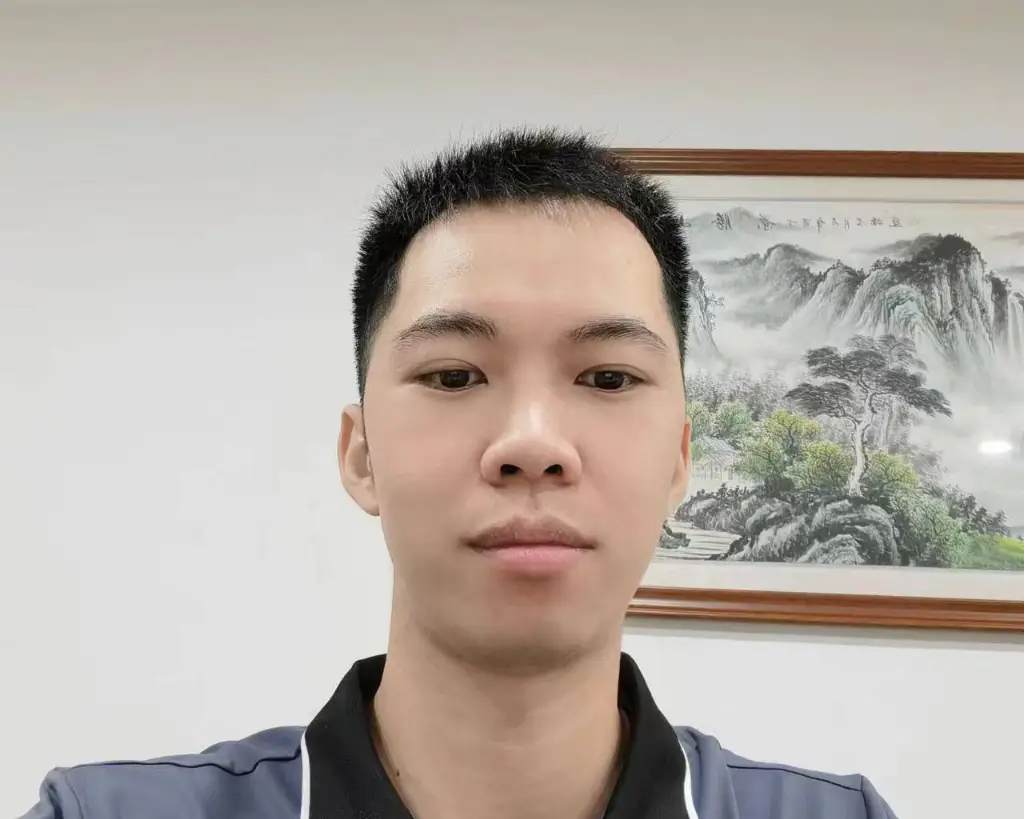
지난 10년 동안 저는 다양한 형태의 판금 제작에 몰두해 왔으며 다양한 워크숍에서 얻은 경험에서 얻은 멋진 통찰력을 이곳에서 공유했습니다.
연락하세요

케빈 리
저는 레이저 절단, 굽힘, 용접 및 표면 처리 기술을 전문으로 하는 판금 제조 분야에서 10년 이상의 전문 경험을 갖고 있습니다. Shengen의 기술 이사로서 저는 복잡한 제조 문제를 해결하고 각 프로젝트에서 혁신과 품질을 주도하는 데 최선을 다하고 있습니다.

